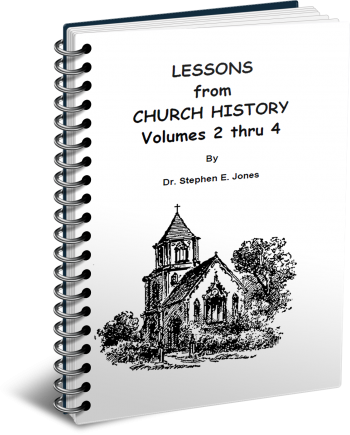Latest Posts
View the latest posts in an easy-to-read list format, with filtering options.

Volumes 2-4. This is the history of the Church from the Roman War (66-73 A.D.) to Constantine and the Council of Nicea in 325 A.D. with lessons to be learned from it.
Category - History and Prophecy

The transformation of the Roman Empire into a Christian Empire took considerable time. It was not completed until the time of Theodosius, who outlawed sacrifice in 381 and finally made Nicene Christianity the religion of the Empire in 391.
But Theodosius also re-divided the empire, which Constantine had reunited earlier in the century. Constantine's prime directive was to unite the empire, and he accomplished this in 324 after the battle of Chrysopolis, where he defeated Licinius, the ruler of the Eastern Empire. But Theodosius divided the Empire once again between his two sons, Arcadius and Honorius at his death in 395.
Constantine himself had two roles to play: Emperor of all Rome, and that of a Christian. As a political equal to Licinius for many years, he was unable to do everything that he wanted, and so he accommodated Licinius prior to 324. He started out with a policy of religious toleration, giving equality to Christians and pagans. Only later did he begin to restrict paganism. It appears that his political goal of re-uniting the Empire spilled over into his ideas of uniting not only Christianity under Christ, but also in uniting the pagan religions under a monotheistic “sun god” of their own.
Hence, one of his first acts was to issue coins—a secular act in itself—with inscriptions Sol Invictus, “to the Unconquered Sun.” These were minted in the mints that he controlled: London, Trier, and Lyons. The Sun was a monotheistic symbol of the Universal Godhead, used by pagans, but also in a positive sense in the Bible in reference to the True God (Psalm 19:4; Mal. 4:2). The moon represents the Church which is supposed to reflect the glory of God—i.e., the Sun. The difference, of course, is in the manner of worship and whether or not one worships the literal sun or He whom it represents.
Constantine found this symbol useful, in that it was acceptable to all religion and yet promoted monotheism. The pagan Romans, of course, worshipped many gods, and yet recognized a Most High God, a King of the gods. Constantine began to bring paganism into monotheism as a first step toward unifying the Empire.
James Carroll's book, The Sword of Constantine, page 185, theorizes that the minting of coins to the Sun was designed to fool Licinius, who did not really understand the underlying difference between Christianity and the pagan Sun-cult. Carroll writes,
“The year 315 was decisive for Christian-pagan relations too. By then Licinius, Augustus in the East, had realized that, despite similarities with the sun deity, the Christian God was different and would not readily take a place among the other gods of the Roman pantheon. It may well have occurred to Licinius that he'd been had by Constantine, for whom toleration was only the first step toward a new, Christian domination. Licinius saw too late that the Milan Edict itself gave a kind of primacy to Christianity: ‘Christian religion’ was named first, and Roman paganism, like all paganism, was referred to as ‘any other cult.’ The growing influence of Christianity would enhance Constantine's power and diminish his own. Seeing this, Licinius began to purge Christians from his civil service. The act gave Constantine the pretext he needed to declare war against yet another brother-in-law.”
In 315 Constantine prohibited Jews from proselytizing. This was one of the first steps toward undoing his policy of toleration. But Constantine continued using Sol Invictus on the coins until 321. After that, it appears that this inscription served no further useful purpose, and it was dropped. In 324 Constantine became sole emperor of the Empire.
His first act was to call a Christian Council to bring unity to the Church in the latest controversy—the Arian controversy. This became the Council of Nicea in 325 and the father of the “Nicene Creed,” focusing mainly upon the issue of the Trinity. The argument of Arius was that “If Jesus is the Son of God, then there was a time when He was not.” Though this controversy was officially won by the Trinitarians, the issue took decades to settle among the people themselves. The fourth century Church was characterized more by this controversy than by any other issue.
From Constantine's viewpoint, unity was essential. He believed that religious unity was important in maintaining the political unity and strength of the Empire. He did not take a position either way in this controversy at the Council of Nicea and personally wavered often even in later years. His goal was to bring the bishops together to discuss and argue their points and come to a unified consensus of opinion. In this, he succeeded only in securing two positions—a majority opinion and a strong minority opinion.
Constantine is one of the most loved and hated figures in Church history. There are many today who blame him for all the problems in the Church, when in fact, carnally minded bishops were the main problem in the Church. Constantine and his successors empowered the Church (i.e., the bishops), and together these men laid the foundations for future problems. Constantine should be held accountable for any political problems in the Empire; but the Church bishops should be held accountable for spiritual problems in the Church.
Those who blame Constantine for the spiritual problems in the Church should ask themselves if they would prefer that the Emperor continue the Diocletian persecution. Persecution does have its way of keeping some purity in the Church, after all. But if we blame Constantine for stopping the persecution and allowing the Church the freedom to become corrupt, then we should also blame every king, president, and legislator that votes to give religious freedom to Christians today. That does not seem like a feasible position.
To blame Constantine for the spiritual problems is unjust, for it loses sight of the most obvious fact that Constantine stopped the persecutions of the Church! That was the greatest victory for the Church since the cross itself. He sought to pay reparations to the Church and give back all the Church property that had been confiscated by earlier Emperors. That, too, was only equitable and just, for it recognized that the Church and individual Christians had been unjustly robbed by the legal system of Imperial Rome.
Yet there are always unintended consequences, even to good policies. Most notable is that the bishops soon saw that they had spiritual authority over Constantine, as much as Constantine had political authority over them. The bishops began to appeal to the Emperor, not only to obtain justice, but soon to enforce doctrinal orthodoxy established by the Church Councils. Constantine was only too willing to do this, because he agreed fully with the bishops that unity was of primary importance. And thus, the Arian dissenters were exiled, and their churches (property and bishoprics) given to Trinitarian bishops.
So both the political and religious authorities felt an overwhelming need to establish unity. Since this kind of policy had not really been tried before, there were few (if any) examples in history from which to learn. It was inevitable that they all had a greater confidence in the power of Pentecost than was warranted. They did not seem to understand that Pentecost was a leavened feast, and this leaven would only manifest in a greater way once the Church had been pulled from the “fire” of persecution.
If they had had a revelation of the Feast of Tabernacles, they might have avoided this, seeing that perfection could come only through this third great feast. But God had not yet opened their eyes to this truth. As the Church became more and more powerful, ultimately eclipsing even that of the political empire itself, it seemed to be settled truth that the Pentecostal Age would increase until the reign of the Church covered the entire earth. The establishment of the Kingdom of God appeared to be possible through Pentecost.
The irony is that as the Church's political power grew, the power of the Holy Spirit was seen less and less. As the Church became more religious, it lost more of the character of Christ Himself. Here is where it would have been most helpful for the people to have understood the story of King Saul and how the Church was the fulfillment of the Kingdom of Saul, rather than of David (as they fancied). If they had made this connection, they might have been able to avoid the same rebellion against God that characterized Saul.
Likewise, the priesthood of the Church was fast reverting to an Old Testament style of priesthood. It came to look more and more like the Levitical, rather than the Melchizedek priesthood. In fact, the cross itself, which Constantine had turned into a conquering sword, restored to the Church the military evangelism that had characterized the Old Covenant and Joshua’s conquest of Canaan.